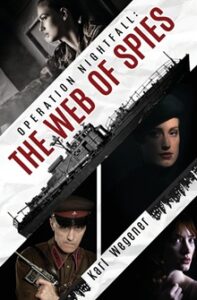Operation Nightfall, by Karl Wegener
The year is 1948. Mankind is still reeling from the effects of WWII. Politics causes mass division. Tyranny threatens to take over. Tensions are high, deception is rife, yet hope persists.
Following the events that occurred between 1945 and 1952 during the Polish anti-communist insurrection, Operation Nightfall sheds the light on the lesser known aspects that transpired during the Cold War. The story focuses on the suffering Poland and its people endured during WWII by those responsible for the Soviet control. The people of Poland are dealing with the loss of their loved ones and nation, but there is a stronger sentiment expressed among these people that haunts the narrative – a sentiment of rage and resentment that drives them to their ultimate goal of liberating themselves from their oppressors.
Wegner expertly establishes a tone of resistance and resilience through the narrative and the protagonists, and one might even argue that it is due to these character’s that such ardent impressions are produced. The descriptions are at once harrowing and immersive, evoking both distress and intrigue amongst readers. Of course, this novel is a work of fiction, but it is inspired by real events that are made to feel even more tangible for the reader due to the authentic way in which the characters are portrayed.
A particularly interesting aspect of this story are the similarities between the characters who are so strikingly different. Despite their contrasting intentions, their motivations are unanimous – revenge. Bialik (and the members of the Home Army) seeks revenge on the Russians for the violence they inflicted on Poland that caused the deaths of so many loved ones. Sokolov, a Lieutenant in GRU, strives for revenge as a way to appease the deaths of his late wife and son. Wegner demonstrates that emotions such as grief are universal and transgress the culture, beliefs, and values of a person.
The story follows each character on their own respective journey of loss, and each person copes and acts distinctly different. They all act on their anger, yet one side is historically more politically violent, ruthless, and inhumane than the other. Wegner illustrates the extent of their sadism, remaining historically accurate in his retelling of events, yet he adds a certain depth to the antagonist Sokolov. He is a person riddled with grief who ironically yet inexorably succumbs to a system that generates even more death, establishing him as a microcosm of the members of GRU who put their faith in an institution that thrives on the violence of oppression and control.
Wegner manages to balance these emotions by creating an equally intense yet more light-hearted tone of unity found within the Home Army. It is here that one finds an intrinsic link between their grief and survival. Their incessant perseverance and unwavering endurance are prevalent and emphasise the strength of the Polish people and their cause. This is a story about a fight for freedom, a fight that didn’t end when the war did, but rather just begun.
Isabella O’Neill is an Editorial Intern at Aspects of History.







